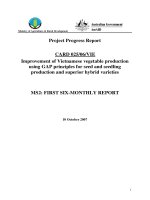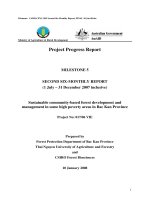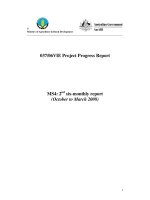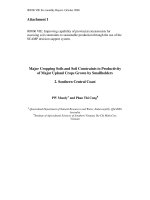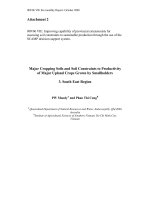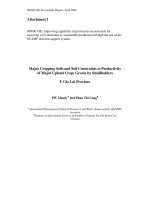Dự án nông nghiệp " Major Cropping Soils and Soil Constraints to Productivity of Major Upland Crops Grown by Smallholders - South East Region " pptx
Bạn đang xem bản rút gọn của tài liệu. Xem và tải ngay bản đầy đủ của tài liệu tại đây (221.73 KB, 11 trang )
009/06 VIE Six-monthly Report- October 2008
Attachment 2
009/06 VIE: Improving capability of provincial extensionists for
assessing soil constraints to sustainable production through the use of the
SCAMP decision support system.
Major Cropping Soils and Soil Constraints to Productivity
of Major Upland Crops Grown by Smallholders
3. South East Region
PW Moody
A
and Phan Thi Cong
B
A
Queensland Department of Natural Resources and Water, Indooroopilly, Qld 4068,
Australia
B
Institute of Agricultural Sciences of Southern Vietnam, Ho Chi Minh City,
Vietnam
2
1. Introduction
The Soil Constraints and Management Package (SCAMP) has been developed
to identify soil constraints to crop production by considering a range of key soil
properties (Moody and Phan Thi Cong 2008; Moody et al. 2008). Once these
constraints have been identified, management practices that ameliorate or modify
these constraints can be formulated. Crops vary in their tolerance to soil constraints
and a soil property limiting the productivity of one crop may not be a limitation to the
productivity of another crop. Therefore, once the constraints of a particular soil type
have been identified, the soil can then be assessed for its ability to potentially support
the production of specific crops.
The objectives of this series of reports are to:
• review existing information on the identification and extent of upland
cropping soils in focus provinces of Vietnam.
• identify the major soils used for smallholder cropping in the focus provinces,
and determine their constraints by the application of SCAMP.
• identify the major crops/cropping systems used by smallholders in the focus
provinces, and document the specific soil requirements of these
crops/cropping systems.
• link soil constraints to the soil requirements of the major upland crops and
develop management guidelines for the management of specific soil types for
specific crops.
Part 3 focuses on the soils and cropping systems of the South East Region
comprising five provinces (Binh Phuoc, Binh Duong, Tay Ninh, Dong Nai, Ba Ria
Vung Tau) and the suburbs of Hochiminh City. The region stretches from 105
o
49’ to
107
o
35’ east longitude and from 10
o
20’ to 12
o
17’ north attitude. The total area is
about 2.2 million hectares (approximately 20.3% of the total land area of Vietnam).
The South East Region receives the highest solar radiation in Vietnam- more than 130
Kcal/cm
2
/year which is favourable for agriculture production. Annual mean
temperature is 26-27
o
C and constant throughout the year. The region receives a high
annual rainfall, from 1800-2400 mm. Rainfall is concentrated in the rainy season
(May to November, 200-300 mm per month) causing soil erosion in sloping areas and
severe leaching of the soil profile. Mean annual evaporation is about 1200-1400 mm.
Because of its favourable climate, the South East Region produces many high value
crops such as rubber, coffee, black pepper, sugarcane, maize, fruit trees and
vegetables.
2. Parent Materials
Basaltic materials of the Pleistocene and Pleistocene-Holocene periods cover
more than 25% of the region (Phan Lieu, 1992). Through a long weathering process,
soils with ‘laterite’-bauxite layers containing nodules are found in the north of Binh
Duong province (Phuoc Long and Dong Phu Districts). The younger basalts form
brownish red soils with a soil depth of 8-10 m in average. These soils are found in
Loc Ninh, Binh Long, Phu Rieng, Xuan Loc, and Dat Do Districts and near the border
with Cambodia in Tay Ninh Province.
Ancient alluvia cover about 33% of the South East Region. The depth of this
material varies from 2-7 m and is predominantly grey in colour. Particle size of the
alluvia ranges from coarse sand to clay. Depending on formation processes, ancient
alluvial has weathered into two different soil groups: grey degraded soils and
yellowish brown soils.
3
Other major parent materials are granite (Nui Ba, Tay Ninh Province; Ba Ra,
Binh Phuoc Province) and schist in the mountainous areas of Tan Uyen, Dong Phu,
and Phuoc Long Districts, Binh Phuoc Province.
3. Major Soil used for Smallholder Cropping
The South East Region has nine major soil groups (Table 1), with Ferralsols
and Acrisols comprising the two major soil groups and accounting for 75% of the
total area.
Table 1. Major soil groups in the South East Region of Vietnam (Source: Phạm
Quang Khánh, 1997).
No Soil types Total area
(ha)
Percentage
(%)
1 Red soils (Ferralsols) 1,018,786 43
2 Grey soils (Acrisols) 744,652 32
3 Acid sulphate (Fluvisols) 170.445 7
4 Black soils (Luvisols) 99.100 4
5 Alluvial soils (Fluvisols) 87.218 3
6 Colluvial soils (Fluvisols) 53.882 2
7 Sandy soils (Arenosols) 28.058 1
8 Skeletal soils (Leptosols) 13.195 <1
9 Saline soils (Fluvisols) 2.500 <1
Ferralsols have good soil physical properties but are poor in chemical fertility.
These soils are important for growing perennial crops such as black pepper, rubber,
fruit trees, cashew and coffee.
Small areas of Acrisols are located at low altitudes and are therefore mostly
used for rice production. Larger areas at high elevation are used for perennial crops
(rubber, coffee, cashew, sugarcane) and annual crops such as cassava, peanut, maize
and vegetables.
Acid sulphate soils occur in low landscape positions near Hochiminh City.
Eucalyptus, pineapple, sugarcane and rice are grown on these soils.
Black soils are found in Dong Nai Province on basaltic materials and in foot-
slope positions in Tay Ninh Province.
4
4. Soil Constraints and Management Practices for Sustainable Crop Production
In general most of the soils in the South East Region are acidic, with low
organic carbon contents and low CEC. Soil constraints to crop production will be
discussed for the two major soil groups: Ferralsols and Acrisols.
Ferralsols
The main constraints identified for the Ferralsols in the region are acidity (a),
low nutrient retention (e) and high P fixation (i). Unlike Ferralsols of the Central
Highlands, variable charge characteristics (geric) are not common in this region. This
could be due to the basalt materials in the South East Region being younger in age,
and therefore less weathered than the basalts of the Central Highlands. Drainage is
the most common pathway of water movement but surface runoff is also a severe
problem as most of the Ferralsols occur in sloping positions in the landscape rather
than on the top of plateaus as occurs in the Central Highlands.
With these constraints, the SCAMP database would indicate the following
management strategies for sustainable productivity:
a: Acid tolerant crops should be grown as a short term response to this
constraint. For long term sustainability, a liming program should be commenced with
regular monitoring of soil pH.
e: CEC should be increased by increasing soil organic matter content
(retaining crop residues, adding organic residues, growing cover crops or companion
green manure crops) in association with a liming program to increase soil pH and
therefore the variable charge component of CEC (e.g., Aitken et al., 1998; Phan and
Merckx, 2005). The practicality of adding high activity clays to increase permanent
charge could be assessed (e.g., Noble et al., 2004).
i: The high P-fixation capacity indicates that high rates of P fertiliser will be
required or special P management practices (i.e. sources and method of P fertiliser
application) will need to be implemented. P fertilization in minimum input cropping
systems should be directed toward the use of minimal P rates applied in bands or
pockets close to the seed, and the use of crops with low P-demand. Band or spot
placement of water-soluble P fertiliser applications will decrease the loss of P
availability by fixation. However, such placement will concentrate roots around the
fertiliser and this may reduce root exploration of the soil profile. In areas that have
short term droughts, this may limit yield because of restricted root access to soil
water. An initial, reduced rate, broadcast fertiliser application accompanying a banded
application should allow a more uniform root distribution. Soil P test levels should be
determined periodically to monitor soil P status.
Acrisols
Large areas of Acrisols are used for growing sugarcane, with Tay Ninh
Province having the largest area. Soil properties of some sugarcane fields are
presented in Table 2.
5
Table 2. Soil properties of some soils growing sugarcane in Tay Ninh Province.
(Source: Sugarcane Research and Development Centre, the IAS)
No.
pH
KCl
Organic
C
(%)
Total
N
(%)
Olsen
P
(mg/100g)
Exch
K
+
(cmol
c
kg
-1
)
Exch
Ca
2+
(cmol
c
kg
-1
)
Exch
Mg
2+
(cmol
c
kg
-1
)
CEC
(cmol
c
kg
-1
)
1 4.43 1.33 0.076 1.4 0.03 0.9 0.5 3.4
2 4.47 1.30 0.067 1.4 0.04 1.0 0.6 4.0
3 5.06 1.35 0.097 1.2 0.06 1.2 0.8 3.5
4 3.87 1.33 0.052 1.9 0.03 0.6 0.2 3.8
5 4.47 1.48 0.120 1.8 0.38 3.0 1.4 7.0
6 4.63 1.43 0.109 2.6 0.50 3.2 2.8 7.7
7 4.45 1.48 0.086 1.1 0.15 1.2 1.0 6.4
8 4.55 1.53 0.084 0.8 0.07 1.1 0.9 4.8
9 3.98 1.38 0.098 0.4 0.05 0.5 0.3 3.8
10 4.13 1.38 0.081 0.4 0.06 1.1 0.7 3.8
11 4.12 1.32 0.083 0.4 0.09 1.0 0.6 3.6
12 4.01 1.38 0.072 1.2 0.04 0.8 1.0 2.6
13 3.85 1.33 0.045 0.1 0.03 0.7 0.5 3.7
14 4.16 1.28 0.067 0.6 0.10 0.6 1.2 3.7
15 4.06 1.28 0.063 0.8 0.04 0.6 0.2 3.0
16 4.00 2.76 0.116 0.8 0.03 0.5 0.3 5.5
17 4.07 2.86 0.073 0.7 0.03 0.6 0.3 6.0
Information from Table 2 indicates that the soils are acidic. Soil organic matter
is generally higher compared with other Acrisols probably due to the recycling of root
residues from ratoon sugarcane crops and the common practice of minimum tillage
(Phan Thi Cong, 1997). The soils have a low CEC and low base saturation.
Additional information on the constraints of Acrisols was obtained by the
project 'Sustainable Agricultural Development in the Uplands of South Vietnam'
(IAS- KUL, 1998). The most commonly identified constraints were low-moderate
organic matter ratings, low K reserves particularly in subsurface layers, and soil
physical problems of hard-setting surfaces and compaction. Some individual sites
suffered from impeded drainage leading to waterlogging and ponding of water. Iron
leaching leaves a typical grey color in the profiles of many Acrisols in the region. In
addition, plinthite in the sub horizons threatens the sustainability of these soils due to
the upwards movement of Fe oxides/hydroxides as a result of capillary rise associated
with high evaporation. Soil compaction very near to the soil surface is a common
constraint.
To address these constraints, the SCAMP database would indicate the
following management strategies:
om (low-moderate): Increasing the levels of organic matter in these soils
would improve nutrient supply, increase CEC, increase water holding capacity and
increase pH buffer capacity. The management of soil organic matter in tropical soils
involves mulching and incorporation of ‘green manure’ crops such as legumes or
forage grasses, retaining all crop residues in the field where the crop has grown, not
burning crop residues, minimum or zero tillage farming systems, strip or alley
6
cropping and application of organic materials (such as animal manure, composted
municipal waste, sewage sludge, and locally available industrial organic wastes)
obtained from off-site.
k: Potassium fertilisers or organic amendments having a significant content of
K will need to be applied. In soils with low K reserves in the subsurface layer, it is
likely that crops will exhibit K deficiency during periods of drought. In these
circumstances, placement of K fertilisers below the seed at sowing or mixing K
fertiliser through the soil in the planting hole is a more efficient management strategy
than sidedressing K fertilisers on the soil surface. Crops should be closely monitored
for K deficiency symptoms.
hs, comp: Hard-setting surfaces reduce infiltration rate and cause poor crop
establishment, while compaction layers restrict root growth and limit rooting depth
causing drought stress to crops. Retaining crop residues and applying surface mulch
should be used to maintain soil surface moisture thus minimising hard-setting. To
minimise compaction risk, soils should only be cultivated when drier than their plastic
limit, and tillage and machinery traffic should be avoided when soil is wetter than its
plastic limit.
5. Major Upland Crops grown by Smallholders
Maize, sugarcane and peanut are the major smallholder crops and the
production areas are indicated in Table 3.
Table 3. Total areas (x 1000 ha) of maize, sugarcane and peanut grown in the
South East Region of Vietnam in 2006 and 2007 (Source: Statistical Year Book
2007).
Province Maize Sugarcane Peanut
Year 2006 2007 2006 2007 2006 2007
Ba Ria Vung Tau 19,0 18,8 0,4 0,5 1,4 1,7
Binh Duong 0,8 0,6 1,1 1,1 3,6 3,0
Binh Phuoc 7,0 6,3 0,8 0,7 1,7 1,2
Dong Nai 56,7 58,2 8,8 8,9 1,6 1,4
Tay Ninh 7,8 7,1 38,0 31,3 20,9 21,3
Hochiminh City 1,2 1,1 2,3 2,0 0,7 1,0
Maize is grown mainly in Dong Nai Province on fertile Luvisols or Lixisols.
On these soils, maize can give high yields of up to 10 tonnes/ha. In Ba Ria Vung Tau
and Tay Ninh Provinces, maize is grown on Acrisols and Ferralsols. Sugarcane is
mainly grown in Tay Ninh Province, and to a lesser extent, Dong Nai Province. A
few years ago, large areas of sugarcane could be found in Binh Duong Province on
Acrisols, but this crop has given way to the urbanization of the province. Peanut has
been grown on the grey degraded soils of Tay Ninh Province for more than 40 years
and still comprises a major crop of the province.
Water availability is the main factor controlling the cropping patterns of the
region. After a long dry season, annual crops such as rice and maize are grown when
the rain starts. Paddy rice is the main crop grown in the low position lands while
maize is grown on the higher land. Peanut or mungbean are planted at the end of the
wet season which coincides with the winter-spring season. Perennials of importance
such as black pepper or coffee are grown in low positions of the landscape where
irrigation water can be managed in the dry season. Imbalanced fertilization is a
7
constraint in management practices of farmers in the region. The efficiency of
nutrient use is very low.
In the South East Region, 83% farmers burn sugarcane crop residues (leaves
and cane top) (Nguyễn Thị Rạng, 2002). The effect of different mulching techniques
using the crop residue of the first crop to cover the ground of the ratoon crop on the
income/investment cost ratio of sugarcane is presented in Table 4. Results show that
mulching improves yield and income compared with residue burning.
Table 4. Effect of different mulching techniques on the income/cost ratio.
(Source: Do Ngoc Diep, 2005)
T
Mulching
Techniques
Yield at 10
CCS
(tonnes/ha)
Product
value
(1.000đ)
Investment
cost
(1.000đ)
Income
(1.000đ/ha)
Income/cost
ratio
1 Residue burning 77,1 29.298 11.741,4 17.556,6 1,53
2 Cover all rows 92,8 35.264 12.238,0 23.026,0 1,88
3
Cover every other
row
97,5 37.050 12.706,8 24.343,2 1,92
6. Soil Suitability for Major Upland Crops grown by Smallholders
SCAMP assessments of the Ferralsols and Acrisols (Section 4 above) have
identified several soil constraints to crop productivity. Some of these constraints have
effects on crop productivity, irrespective of the crop grown: erosion (er), low CEC
(e), high P fixation (i), low organic carbon (om), K deficiency (k), and hardsetting
characteristics (hs). However, crops vary in their tolerance to other constraints such as
drainage and acidity; while a particular soil attribute or constraint might be a major
limitation to the productivity of one crop, it may pose only a minor limitation to
another. The FAO (1976) framework for land evaluation uses five classes to
categorise the suitability of a specific soil/landscape unit for growing a particular crop
(Table 5). To facilitate the use of SCAMP for this application, individual soil
attributes/constraints identified for the Acrisols and Ferralsols have been rated
according to their effects on the sustainable production of the major crops grown by
smallholders in the South East Region (Table 6). Ratings are based on collation of
information in Williams (1975), Landon (1984), Page (1984), Schaffer and Andersen
(1994), Robinson (1996) and Dierolf et al. (2001).
8
Table 5. Soil suitability classes [Source: FAO 1976]
Suitability
Class
Criterion Description
1 Highly suitable Soil is suitable for sustainable
production of the crop without
ameliorative measures.
2 Moderately suitable Soil is suitable for sustainable
production of the crop if minor
ameliorative measures are applied (e.g.
liming, mounding to improve local
drainage).
3 Marginally suitable Soil is only suitable for sustainable
production of the crop if major
ameliorative measures are undertaken
(e.g. large scale drainage works).
4 Currently not suitable Soil is not suitable for sustainable
production of the crop.
Table 6. Suitability class of soil attributes/constraints for production of specific
crops.
SCAMP
descriptor
Maize Sugarcane
Peanut
Texture
S 2 2
2
L 1 1
1
C 1 1
3
O 3 3
3
Drainage
1 (g) 4 4
4
rating
2 (g
-
) 4 3
3
3 3 2
3
4 1 1
2
5 1 1
1
6 1 1
1
Slope (%)
0-2 1 1
1
2-5 1 1
1
5-10 2 2
2
>10 3 2
3-4
Soil pH
a
-
2 1
1
a
3 2
2
Drought tolerance
L L
M
Main nutrient
/water uptake zone
(cm)
80-100 >100
50-
100
Nutrient
needs
High N, K
req'd
High N req'd
Ca in pegging
zone
9
The following comments apply to the management practices that may need to
be undertaken to meet the requirements of individual crops in addition to those
already outlined in Section 4 above.
Texture
S: Because of the low inherent plant available water content of sandy soils,
irrigation may be required for crops of low drought tolerance such as maize,
sugarcane and coffee. Using surface mulches of plant residues will reduce evaporation
and conserve soil moisture.
For crops with high nutrient demands such as maize, sugarcane and coffee, the low
ECEC of sandy soils requires that nutrient cations such as potassium are applied in
split applications at rates in accord with crop demand. Growing green manure crops or
applying plant material from these crops (eg. Tithonia) will temporarily increase the
nutrient holding capacity (i.e. CEC) of the soil.
C: Root crops such as cassava are not suited to clayey soils because of
harvesting difficulties. Clayey soils are unsuitable for crops that do not tolerate
prolonged soil wetness such as coffee; the low permeability of clayey soils causes
them to remain wet for a longer period than soils of lighter texture.
Drainage
Soils with imperfect or poor drainage are unsuitable for crops that cannot
tolerate waterlogged conditions such as coffee and maize, and raised beds and large
scale drainage works must be undertaken if such crops are to be grown.
Acidity
a: Soils with this constraint are unsuitable for crops with a low or moderate
tolerance to Al and/or Mn toxicity such as maize and coffee unless a comprehensive
liming program is undertaken.
a
-
: These soils require a liming program if they are being used to grow crops
of low tolerance to Al toxicity such as maize and coffee. Applying Tithonia residues
to acidic soils has been shown to ameliorate soil acidity by increasing soil pH. An
added benefit of using fused magnesium phosphate (FMP) as a P fertiliser is that it
also has a liming effect.
Main nutrient/water uptake zone
Crops with a comparatively shallow active rooting depth will not be as
sensitive as deeper rooted crops such as coffee and sugarcane to constraints such as a
compaction layer (comp).
Conclusions
Ferralsols and Acrisols are the major arable soil groups in the South East
Region. The constraints to crop production which are likely to occur in the Ferralsols
are acidity, low nutrient cation retention, and high P fixation. For Acrisols,
commonly occurring constraints are low-moderate organic matter ratings, low K
reserves particularly in subsurface layers, and the soil physical problems of hard-
setting surfaces and compaction.
The upland crops most commonly grown by smallholders in the region are
maize, sugarcane and peanut. Individual crop tolerances to some of the identified
constraints vary, and so soil management responses to ameliorate or minimise the
10
effects of these constraints on crop productivity will also vary. However the use of a
liming program and application of green manures to the Ferralsols is required by all
crops, while improving drainage, maintaining a surface mulch, and applying green
manures are essential practices for the Acrisols.
References
Aitken, R.L., Moody, P.W. and Dickson, T. 1998. Field amelioration of acidic soils in
south-east Queensland. I. Effect of amendments on soil properties. Australian
Journal of Agricultural Research, 49, 627-637.
Dierolf, T., Fairhurst, T. and Mutert, E. 2001. Soil Fertility Kit. Potash and Phosphate
Institute: Singapore.
Do Ngoc Diep 2005. Nghiên cứu một số biện pháp kỹ thuật chăm sóc mía ban đầu
cho cây mía ở Nam Bộ. Project Report. Centre for Sugarcane Research and
Development. Institute of Agricultural Sciences of Southern Vietnam.
FAO. 1976. Framework for land evaluation. Soils Bulletin No. 32. FAO: Rome.
Institute of Agricultural Sciences of Southern Vietnam and Katholieke Universiteit
Leuven 1998. Final Report on 'Sustainable Agricultural Development in the
Uplands of South Vietnam. IAS-KU Leuven: HoChiMinh City.
.
Moody, P.W. and Cong, P.T. 2008. Soil Constraints and Management Package
SCAMP): guidelines for sustainable management of tropical upland soils.
ACIAR Monograph No. 130, 86pp. Australian Centre for International
Agricultural Research: Canberra.
Moody, P.W., Phan Thi Cong, Legrand, J.
and Nguyen Quang Chon 2008. A
framework for identifying soil constraints to the agricultural productivity of
tropical upland soils. Soil Use and Management 24, 148-155.
Noble, A.D., Ruaysoongnern, S., Penning de Vries, F.W.T., Hartmann, C. and Webb,
M.J. 2004. Enhancing the agronomic productivity of degraded soils in
northeast Thailand through clay-based Interventions. In: Water and
Agriculture (eds. Seng, V., Craswell, E., Fukai, S. & Fischer, K.), ACIAR
Proceedings No. 116, ACIAR, Canberra, pp. 147-160.
Nguyễn Thị Rạng 2002 Ảnh hưởng của các liều lượng phân bón N K đến năng suất,
chất lượng mía. MSc. Thesis. Centre for Sugarcane Research and
Development, Institute of Agricultural Sciences of Southern Vietnam:
HoChiMinh City.
Page, P.E. 1984. Tropical Tree Fruits for Australia. QDPI Information Series QI
83018. Queensland Department of Primary Industries: Brisbane.
Pham Quang Khanh 1997. Tai nguyen dat Đong Nam Bo.
11
Phan Lieu 1992. Dat Dong Nam Bo (The soils of the South East Region). Nha xuat
ban Nong Nghiep (Agricultural Publisher)
Phan Thi Cong 1997. Sustainability of different cropping systems on Haplic Acrisols
of South Vietnam. Journal of Science, Technology and Economic
Management 11, 482-484.
Landon, J.R. (ed.) 1984. Booker Tropical Soil Manual. Longman Inc.: New York.
Phan, T.C. and Merckx, R. 2005. Improving phosphorus availability in two upland
soils of Vietnam using Tithonia diversifolia H. Plant and Soil 269, 11-23.
Robinson, J.C. 1996. Bananas and Plantains. CAB International: Oxon.
Schaffer, B. and Andersen, P.C. 1994. Handbook of Environmental Physiology of
Fruit Crops. CRC Press: Florida.
Statistical Year Book, 2007. Statistical Publishing House: Hanoi.
Williams, C.N. 1975. The Agronomy of the Major Tropical Crops. Oxford University
Press: London.


